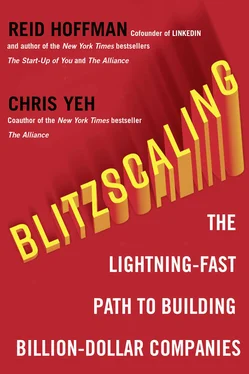Whether you are a founder, a manager, a potential employee, or an investor, we believe that understanding blitzscaling will allow you to make better decisions in a world where speed is the critical competitive advantage.
With the power of blitzscaling, the adopted son of a Syrian immigrant (Steve Jobs), the adopted son of a Cuban immigrant (Jeff Bezos), and a former English teacher and volunteer tour guide (Jack Ma) were all able to build businesses that changed—and are still changing—the world.
The strategy and techniques we describe in this book are based on my experiences as a member of the founding team at PayPal; as the cofounder, CEO, and now executive chairman at LinkedIn; as a leading investor in Facebook and Airbnb; and as an investor at Greylock Partners, where I worked with many other billion-dollar companies, such as Workday, Pandora, Cloudera, and Pure Storage. My partners at Greylock and I have helped these companies go from garage to global dominance, and, in this book, we’ll share with you what we believe are important frameworks for understanding and addressing the challenge of blitzscaling across the different elements of your organization.
Yet as many good business books disclaim, while this is a playbook and a strategy guide, it isn’t a book of precise recipes. Regardless of how the popular press portrays things, each formula for building a great company is unique and depends on the market opportunity, the founders, and the network in which they operate. The truth is there is absolutely nothing guaranteed as a one-size-fits-all, must-follow rule book for everyone. However, there are patterns. So in addition to individual tips and tricks, this book offers a set of frameworks and strategies for leaders, entrepreneurs, and intrapreneurs to adapt to their own needs and circumstances.
A QUICK NOTE ON THE TERM “BLITZSCALING”
The term “blitzscaling” derives from the twentieth-century usage of “blitz” as a way of describing a sudden, all-out effort. The first usage of blitz in this way was to describe the “blitzkrieg” (“lightning war”) strategy that General Heinz Guderian devised for the initial military campaigns of Nazi Germany during World War II. Ironically enough, Guderian was heavily influenced by British military thinkers like Basil Liddell Hart and J. F. C. Fuller, and the term “blitzkrieg” was actually popularized by the British press; the German military never formally adopted it.
The advancing armies in these campaigns abandoned the traditional approach of moving at the slow pace at which they could establish secure lines of supply and retreat. Instead they fully committed to an offensive strategy that accepted the possibility of running out of fuel, provisions, and ammunition, risking potentially disastrous defeat in order to maximize speed and surprise. The speed of these armies’ advance shocked and overwhelmed their opponents, allowing the blitzkriegers to outmaneuver and outfight the defending forces.
The early success of the German army helped spread the lessons of blitzkrieg to all the forces in the war. For example, the American general George S. Patton later put these lessons to good use in leading the US Third Army’s advance from the beaches of Normandy all the way to Berlin. Since then, the term “blitz” has been used to describe everything from an American football play to the way in which large corporations roll out new products. Like the all-out blitz defense in football—which involves the risky move of sending every available defender to pursue the quarterback—or the proverbial marketing blitz of television, print, and online advertising that accompanies the release of a new blockbuster movie, blitzscaling strives for a relentless and dizzying speed that overwhelms the market.
While we are wary of the negative connotations of “blitz,” especially in those nations that felt the effects of blitzkrieg in World War II, we believe that the strength of the metaphor and the widespread and colloquial use of the term in nonmilitary contexts make it the best fit for the concepts discussed in this book.
Конец ознакомительного фрагмента.
Текст предоставлен ООО «ЛитРес».
Прочитайте эту книгу целиком, купив полную легальную версию на ЛитРес.
Безопасно оплатить книгу можно банковской картой Visa, MasterCard, Maestro, со счета мобильного телефона, с платежного терминала, в салоне МТС или Связной, через PayPal, WebMoney, Яндекс.Деньги, QIWI Кошелек, бонусными картами или другим удобным Вам способом.












